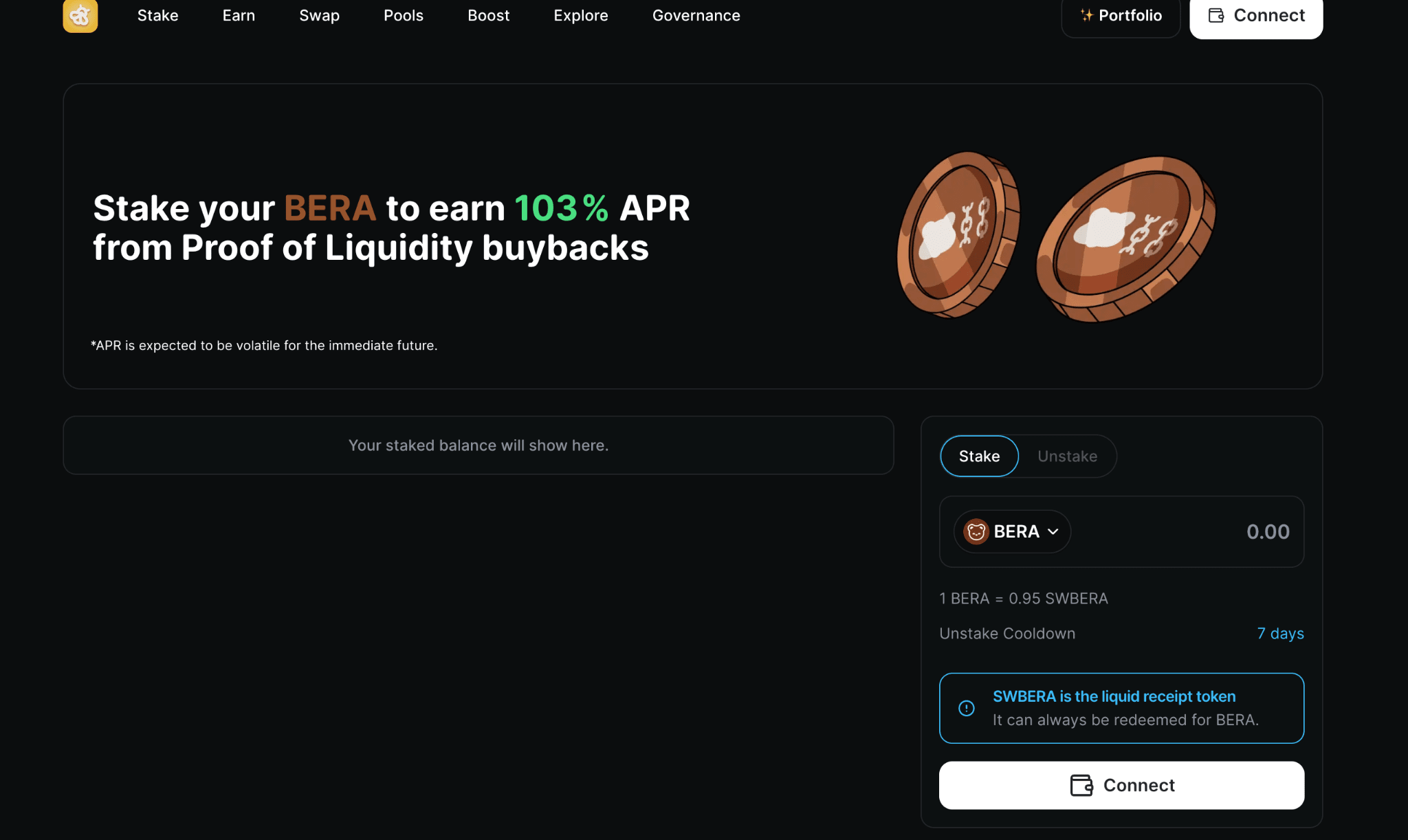Berachain is a distinctive Layer 1 blockchain project, and its most recognizable innovation is the adoption of the PoL (Proof of Liquidity) block reward distribution mechanism. This mechanism transforms the chain's block rewards into an economic mechanism that drives ecological growth by directly distributing the majority of rewards to users and liquidity providers within the ecosystem, thereby driving application growth and on-chain liquidity accumulation.
In this model, all ecological assets participating in staking will directly provide on-chain liquidity support for Berachain. The rewards generated from PoL liquidity mining come from the chain's native incentive mechanism, which aims to build a more capital-efficient and incentive-oriented underlying structure.
Berachain recently upgraded its PoL consensus mechanism and officially released the new V2 version. This mainly involves the introduction of a new token economic model, further clarifying the rights and value support of the $BERA token.

1. Let's first talk about the PoL consensus mechanism.
In fact, the operational logic of PoL is both simple and interesting. It integrates the PoS consensus mechanism, liquidity mining, and the veCRV liquidity game model introduced by Curve, creating a new paradigm for on-chain governance and incentive distribution.
Berachain currently designs two core native on-chain assets:
BGT: As the native governance token and the dominant asset for incentive distribution;
BERA: As the staking asset for validators, it also bears the function of on-chain Gas fees.
Meanwhile, the main participant roles in the PoL model include: on-chain protocols in Berachain, validators in the network, and liquidity providers (LP).
In this mechanism, any protocol or DApp wishing to obtain BGT incentives must first apply to join the whitelist pool of the PoL rewards treasury and provide sufficiently attractive bribes to attract validators' BGT allocations. The validators of Berachain are the block-producing roles in the network (to become validators, they need to stake BERA tokens). When validators successfully produce a block, the system provides them with BGT token rewards, consisting of two parts:
A part of it is the basic block reward for validators.
Another part is referred to as 'quantity variable rewards', which means the system will allocate different amounts of BGT tokens to validators based on their 'Boost' values (calculated as the percentage of delegated $BGT to the total delegated $BGT across all validators). The higher the 'Boost' value, the more BGT token rewards this part will receive, and it will decay after reaching a peak, ensuring the fair distribution of BGT.
After successfully producing a block and receiving rewards, validators will distribute most of this variable reward to the approved whitelist PoL pools according to their own strategies through the BeraChef contract. In fact, when validators distribute variable BGT rewards to Reward Vaults, they will also receive incentives at the rate set by the vault owner, such as HONEY, USDC, or returns provided by the vault.
Protocols that can typically provide higher returns for LPs can also bring better returns for validators. Therefore, validators tend to allocate more BGT rewards to PoL pools that can provide higher protocol incentives.
The PoL pool of the protocol distributes BGT rewards to LP users after receiving them, so you will see that becoming an LP in some of Berachain's PoL pools not only earns regular farming rewards (such as fee sharing, protocol's own governance token rewards, etc.) but also receives native BGT token incentives from the protocol, typically resulting in a high APY.
For BGT stakers, they can delegate BGT tokens to validators to help them improve their 'Boost' values. In turn, validators will periodically distribute the above-mentioned protocol bribes to the BGT delegators supporting them according to a predetermined ratio.
Therefore, we see that under the PoL model:
First, protocols usually form long-term games to achieve better circulation, continuously attracting liquidity through yields. This 'yield arms race' will bring better liquidity foundations to Berachain.
Secondly, validators are also engaged in competition, hoping to attract more BGT holders to support themselves for better 'Boost' values and potential returns. Therefore, validators are constantly helping the network optimize liquidity.
Therefore, thirdly, whoever can provide more liquidity will have more power and economic returns, continuously forming a growth flywheel that integrates liquidity, security, and incentive distribution.
2. What has POL v2 brought?
In fact, in Berachain v1, the BGT token, which integrates governance and incentive functions, has deeply integrated into Berachain's economic circulation system. As an incentive asset with inflation attributes, BGT has clear native use cases at the chain's underlying layer and possesses sustainable income capabilities.
In contrast, the economic role of the other core token BERA in the v1 phase is relatively weak. Apart from bearing Gas fees and serving as the collateral for validators, users have little means to obtain on-chain returns from BERA in a native manner. Therefore, most BERA holders can only rely on third-party DeFi protocols, such as participating in LP farming in PoL pools that support BERA or its wrapped assets to indirectly obtain returns. However, these pathways often have high thresholds, complicated operations, and poor experiences.
Similarly, in the current increasingly stringent global compliance environment, BERA and other native PoS assets on the chain face similar issues, namely the lack of compliance-friendly income models, making it difficult for institutional users to adopt or incorporate into the traditional financial system, thus limiting market expansion.
Thus, the most intuitive change for Berachain in v2 is that it introduced the BERA incentive module, allowing BERA to better embed itself into the Berachain economic ecosystem and empower the ecosystem without significantly altering the existing economic ecosystem.
BERA Incentive Module
In v2, Berachain further introduced the BERA incentive module, allowing users to stake BERA tokens directly in a single-coin staking manner through Berahub to obtain native returns from the chain's ecosystem.
In fact, the BERA incentive module itself is similar to a staking method. If users stake BERA tokens natively, the system will first convert them into the wrapped token WBERA, then stake them on the network and provide a proof token sWBERA in return. Additionally, users can directly stake WBERA tokens, and the system will also provide a proof token sWBERA.
Similar to Lido's stETH, the sWBERA token resembles an LST, which can serve as a proof asset and also has the potential to capture returns in Berachain's DeFi protocols, enhancing capital utilization for multiple benefits.
In v1, BGT holders delegated BGT to validators to help them increase their 'Boost' value.
When users stake BERA tokens, they directly stake them into Berachain's contract, resulting in a user experience similar to single-coin staking in PoS, rather than delegating to validators. However, it is important to note that redeeming sWBERA for BERA requires a 7-day unlock period.
From the perspective of income sources, in v1, the income for BGT stakers comes from the bribe income that validators earn after providing incentives for specific PoL pools (additional incentives obtained from the treasury or related protocols). After deducting delegation fees, most of this is distributed to BGT stakers. In v2, this bribe income will have 33% repurchased as WBERA and then distributed to BERA stakers (reinvestment). The amount of staking income users receive depends on the proportion of their staked BERA tokens relative to the total.
We see that in v2, the threshold for users to earn income from BERA has been significantly lowered. They can stake directly at the chain's underlying layer, which is safer and more reliable. Users no longer need to go through third-party protocols to become LPs or delegated stakers.

From the perspective of returns, the current yield for single-sided staking of BERA can reach 103% (making it the highest yield for single-coin staking among Layer 1s), which is a very, very considerable return state. Although CEX also has BERA earning functions, the overall returns are around 60% to 90%. Overall, directly staking on the chain, such as on Berahub, is more cost-effective (https://hub.berachain.com/stake/).
BERA staking returns have a real source of income.
In fact, the native staking of BERA does not rely on inflation to 'print tokens for distribution'; its mechanism itself has real income support.
This is actually quite understandable. In Berachain's PoL model, the protocol bribes validators to compete for BGT rewards. Most of these bribe funds come from the protocol's own treasury and are paid in the form of stablecoins, mainstream assets, or protocol tokens. These funds are not directly given to the validators but are subjected to a 33% service fee collected by the system, which is auctioned off for WBERA and finally distributed proportionally to users who stake BERA.
In other words, although BERA rewards are indeed issued on-chain, this is not inflation created out of nothing like other PoS networks. I have real funds as backing, and this process is similar to the network selling the 'right to issue tokens' and then distributing the cash income to the stakers.
In this regard, Berachain's article provides a good example that I think is nice.
If both ETH and BERA issue $100M of tokens annually:
ETH directly gives stakers $100M;
Berachain sells inflation through a bribery mechanism. If the efficiency is 80%, it will receive an additional ~$80M in real income.
The result is: with the same inflation, Berachain can achieve $180M in on-chain value return, while ETH only achieves $100M.
Therefore, the staking returns of BERA belong to 'real returns at the protocol layer', which are not only more sustainable but also provide long-term value support for its native staking scenarios.
Institutional Friendliness
Another aspect is the institutional friendliness mentioned by Berachain.
Earlier, we mentioned that the Berachain PoL v2 model turns inflation into real income for the protocol, constructing a clear and transparent model of on-chain real income for BERA, which does not rely on third-party protocols or secondary market speculation, but entirely comes from real bribe expenditures of on-chain protocols, which are transformed into traceable incentive funds through auctions.
The income generated by this model can be directly packaged, split, and distributed in a unified manner in a CEX custodial environment, allowing BERA's staking to have the potential to be packaged by institutions as financial products, custodial agreements, and structured income tools. This effectively addresses the pain point of being difficult to directly reach institutional users.
On the other hand, I recall the recently highly discussed Clarity Act, which establishes a clearer compliance framework for crypto assets. Thus, the introduction of PoL v2 is timely, binding income to real economic behavior at the mechanism level. On-chain financial instruments should have clear income sources, an auditable underlying structure, and asset attributes that are custodial and explainable to holders. This aligns with the direction advocated by the Clarity Act.
If BERA launches a Digital Asset Treasury in the future, it will also provide a compliant, custodian, and continuously cash-flowing on-chain income path for institutions and even publicly listed companies.
So overall, the significance of the v2 launch is not only to accelerate the flywheel within the ecosystem but also to embody a more in-depth and long-term ecological development strategy.


